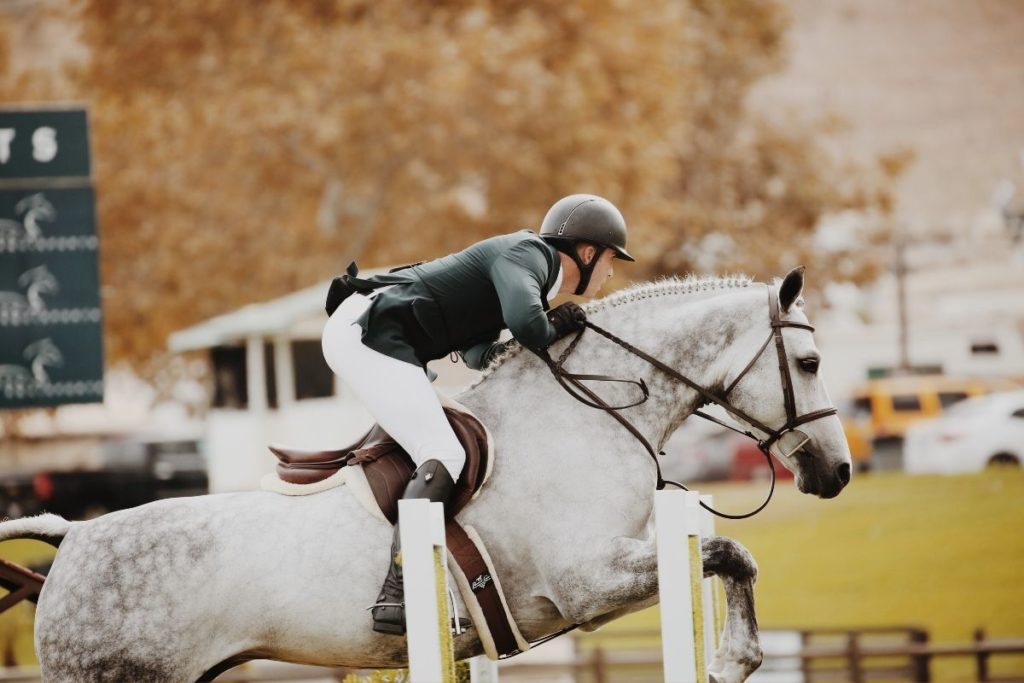Horse riding makes you feel freer than the wind. That is until you are brought back down to earth with knee pain. Unfortunately, knee pain is a common phenomenon with some equestrians. But before we can talk about the solutions, the reason why knee pain is common must be tackled.
A combination of lower body position, feet position, and ankle position during riding can cause knee pain in equestrians. There are, however, simple posture changes that can prevent knee pain during horse riding.
This article will not only address the proper lower body, feet, and ankle positions horse riders should know; it will also provide information on knee gripping and exercises that focus on strengthening these parts of your body.
Does Horse Riding Damage Your Knees?
Many horse riders report feeling knee pain akin to walking up the stairs or having a prolonged hiking trip. Improper horse riding has the potential to cause this pain.
The correct posture is important when you are riding a horse. Every part of your lower body, legs, and feet needs to be set in a certain way to avoid causing pain.
The damage that you incur from horse riding is usually not severe. In more cases than not, knee damage requiring corrective surgery is due to a direct impact from a fall of some sort. So, you do not need to worry about needing knee surgery from improper horse riding.
How to Treat Your Painful Knees at Home
If you are experiencing knee pain while riding your horse, and it so painful you feel you cannot ride, you should get off your horse. You will need to take steps to heal your knees so you can get rid of the pain.
Usually, ice packs and rest are good ways to help the pain subside. Pain relievers like ibuprofen and acetaminophen will help with pain too. Keep your knees elevated for a long time and maybe take a nap. Keeping pressure off your knees for a while should help a lot.
If the pain persists, however, it would be wise to visit your doctor and get professional advice on what you can do to cure it. If you do visit your doctor, you will likely be told to set up an appointment at a physical therapy center nearby to help strengthen your knees.
How Do I Stop My Knees from Hurting When Riding A Horse?
There are three running themes when it comes to knee pain in horse riding: lower body position, feet position, and ankle position.
The key is to remain in balance with your core muscles, your seat, and your horse.
Check Your Lower Body Position
One of the most common causes of knee pain is a bad leg position. There is a sweet spot that all equestrians should try to achieve when riding a horse.
While riding a horse, your hips are always meant to be directly below your shoulders. If you are doing a sportier event and your horse jumps, your ankles need to be directly below your shoulder as well.
Of course, all of this will be taught to you if you have a good horse-riding trainer, but having an online guide is still good for those who are experiencing knee pain.
Change Your Foot Position
Stirrups should be placed underneath the ball of your foot (the section of your foot that is right under your toes). This is to make sure your ankle flexes with the movement of your horse. However, if your saddle is not secure, your feet will slide forward, which makes the bar of the stirrup rest on the arch of your foot rather than the ball of your foot.
Your ankles lose the ability to flex when the horse moves, and the entire leg will slide in the stirrup with each move the horse makes, causing incredible pressure and pain on your knee.
To prevent your arch from sliding down on your stirrups, you need to be secure on your seat. Your body needs to be balanced, and you need to maintain control of your horse.
Fix Your Ankle Position
As mentioned earlier, you need to have your ankles directly below your shoulders while your horse is jumping. But it is also important to focus on your ankles.
One early lesson you may have been taught as a horse rider is to keep your heels down while riding. This lesson is taught early so you can maintain control of your seat. If your ankles and heels go up while your toes point down to the ground while riding, the seat becomes unstable, causing you to bounce like crazy while riding your horse.
Also, when your heels are up, they can hit onto a horse’s side, which causes background noise that the horse does not want to hear. Horses will become confused by the sudden noise caused by your foot.
Part of being an equestrian is being flexible enough to keep your ankles and heels where they are supposed to be as you ride your horse. Check out these exercises from theridinginstructor.net for information on how to improve your flexibility when you ride your horse.
Should You Grip with Your Knees When Horse Riding?

You may think that you need to grip onto your horse, but to grip while horse riding is a bad idea. This can cause a variety of problems for you and your horse.
If you grip your horse with your knees, you will end up pushing roughly against the horse, which causes a restriction of the horse’s movement. The horse will become jittery and jerky, and you will be tossed around in no time.
What Should You Do to Maintain Seating on Your Horse?
Maintaining your seating is simpler than what you’re thinking. There aren’t any secret techniques to keep a steady grip on your horse while riding. Just don’t grip your horse.
Think of it as a church song with a call and response framework. The horse moves. As your horse moves, your seat and your body move with the horse naturally, flowing like the wind.
Whiteroseequestrian.com has a few exercises that can help you maintain your seating better on your horse and build up your strength.
Exercises to Help Strengthen Your Knees
Having strong knees before horse riding is possibly the best way to prevent your knees from pain and possible damage. As I’m sure most of us know, physical therapy is costly. There are, however, some exercises that you can do at home to help strengthen your knees.
Bridging
While lying on your back, bend your knees and push your heels into the floor. Tighten your glutes and abdominal muscles while lifting your hips off the floor. Hold that same position for 5-10 seconds. Repeat 15-20 times.
Clam Exercise
Think of the clam exercise like a sideways bridge. Lie on the side of your body with your knees and hips bent together. Raise your upper leg (not with your foot) slowly, keeping your feet touching each other during the process. Hold for a few seconds and lower your leg slowly. Repeat for about 20 times.
Quad Sets
While on the floor, keep one of your legs straight. Bend your other leg. Press the back of your straight knee on the floor by tightening your upper thigh muscles. Keep this position for about 10 seconds, and then let go. Start again and repeat about 20 times. Then, do your other leg.
Conclusion
Now you know why your knees hurt after horse riding and many ways to stop the pain! We hope that the tips and information in this article will help you move toward a pain-free horse-riding experience.
